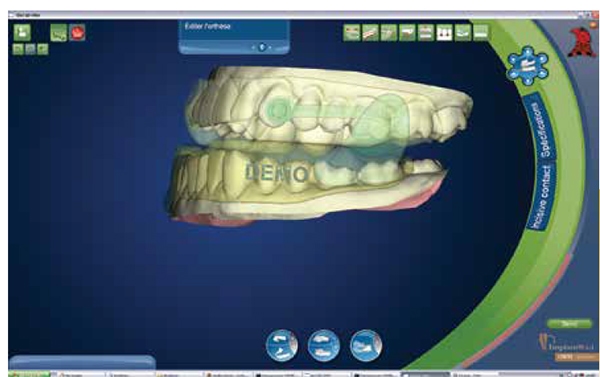
“It doesn’t matter
if the guy is perfect
or if the girl is perfect,
as long as they are perfect
for each other.”
– Matt Damon — “Good Will Hunting”
by Steve Carstensen, DDS, DABDSM
Keep that quote in mind as you sit with your patient and decide which of the over 100 FDA cleared mandibular advancement devices (MAD) is the right one to open the airway. There is no universal appliance, just like there is no ‘standard’ patient! So how do we go about this decision?
Dr. Pankey taught us a philosophy that includes the relevant parts: “Know Your Patient, Know Your Work, and Apply Your Knowledge.” Let’s see how this applies to Oral Appliance Therapy.
Know Your Patient
Your patient comes with a history critical for you to understand. There is a different way to approach people who have never used any sort of acrylic device on their teeth than there is for someone who has worn a bruxism guard every night for years. For the inexperienced patient, assurance of safety and custom fit of your recommended MAD would be paramount; for those with plenty of experience, the similarities can be emphasized to make them more comfortable with the next step. The first patient has to trust they can adapt to something completely new; the latter, just something different.
History also includes psychological information. Some patients will express great reluctance to use any device that holds their mouth closed; often accompanied by reports of ‘claustrophobia.’ In my experience, I have often found these patients to have a history of abuse that lies not far below the surface. Assuring them of choosing a device with plenty of freedom of movement is one way to avoid triggering emotions that may block successful use of even the best MAD. Most people do not want to share with me details of these memories, and I do not want or need to know, either, but I do want them to feel safe.
Nearly all custom MAD are adjustable; your patient may be expected to advance the device until subjective symptoms are resolved. Devices vary in the simplicity of adjustment, some require small tools to be used in tiny holes; some are clearly marked and some patients must refer to printed instructions to see what to do. No matter which one you have made, you must be sure your patient is capable of performing the specific task required. Have them demonstrate competency in your office where they can be coached. Your dental team has been coaching people on how to take care of themselves for years – these skills can be easily adapted.
Does your patient have a significant bruxism history? Many people have poor (admitted) awareness of this movement disorder despite extensive physical evidence of the effects of it. If they have comorbid OSA, you can assure them your device will ‘treat both problems’ without making them admit they brux. It is still not valid to assure these people that bruxism will cease with an open airway, so choose wisely – some devices can withstand the extra muscle activity of sleep bruxism more than others. Again, they feel safe.
Know Your Work –
Apply Your Knowledge
What about physical characteristics? If your patient has significantly limited range of motion or, on the other hand, has excessive mandibular mobility, each of these limits your choices. A small opening may require a small device with separate units for maxillary and mandibular arches. Someone with excessively wide opening may have trouble with retention for devices connected with buccal hinges. ROM has implications for TMJ health, so the sleep dentist must be well informed about the relevant anatomy, physiology, and pathology of these complex body parts.

Patients have unique features such as exostoses, crowded nasal airways, asymmetric protrusive pathways, and widely divergent tooth axial inclinations that influence design choices. One common finding is narrow, restricted arch forms that leave little room for the tongue. Further encroachment on the lingual side of the arch may crowd the tongue further into the airway. Choose a device with as a little lingual presence as possible. Conversely, some patients have significant hyperkeratosis along the occlusal plane in the buccal tissue. Placing the adjustment mechanism buccal to the teeth is asking for trouble as your device competes for limited space.

Are you sure your patient will respond to the MAD with an open airway? Not likely – and some patients are reluctant to invest in a full custom MAD without some ‘proof.’ Thankfully, we can now choose among several professional-level ‘temporary’ MAD that give those patients (and you!) some ability to know whether this is the right therapy for them. The MATRx system is employed in several sleep labs to identify MAD responders before the custom device is chosen.
Materials used in device construction are important for a select subset of your patients. Many people are allergic to nickel, removing stainless steel from the possibility list. Others react to plastic; have examples on your desk to show them, and make sure you ask again the questions from the medical history, as they might not think to make the connection between reactions to “cheap jewelry” and your professional device. There are appliances that are entirely hypoallergenic. Some devices have multiple layers of different materials, possibly leaving gaps that are difficult to clean or provide failure points.
The easiest aspect for dentists to master is deciding whether there is sufficient anchorage available to hold the mandible forward. There are designs that work for the edentulous maxilla, but the lower arch requires stable teeth or implants to be useful. Some appliance designs stabilize mostly on anterior teeth, others posterior. Be aware of where the forces from advancement are concentrated by the hinge mechanism. Obviously, the right choice must be made here to have any hope of success.
Should cost be a factor? There is a wide range of lab cost between the simplest and most complex or robust devices. Even those with similar designs come with different costs – like many things in life, often one gets what one pays for. Be careful saving money on lab expense if it costs in terms of device reliability or longevity. Never lose sight of the fact that our patients, and our medical colleagues, have little understanding of device therapy and expect them to work ‘as promised’ so early failure will not go over well. Most people think of these devices as ‘expensive’ anyway – if you need a slightly higher fee to support a top-quality lab cost, the extra amount will fade in memory as the device serves for years without problems, especially as you remind them of this happy result. No one with a failed device will thank you for saving them a few bucks on the front end.
Be careful saving money on lab fees if it costs you device reliability
Scientific research has rarely been designed to differentiate between individual appliances; most published studies use a chosen MAD to compare to PAP therapy. This doesn’t give us a great way to use science to establish one device as ‘better’ than another. What the informed dentist can do is notice which appliances have been used in many of these studies; those documented results are useful when discussing oral appliance therapy with medical colleagues.
Pain and dysfunction accompany sleep disruption, TMD, and joint instability. Should you shy away from treating patients with such complications? You choose, based on your training and comfort levels as well as the examination details you determine. Every dentist comfortable with sleep therapy will have skills with acrylic devices – find similarities among the variety of MAD available and translate those skills to the wider scope of therapy required to open the airway. Claim your expertise!
With the variety of device choices and an entirely unique population of patients, every dentist who treats sleep disordered breathing must master several appliances and be adept at a few others. Thankfully, there is no reason to use each of the 100+ on the market; but don’t limit yourself to one or a few, either. You are the matchmaker – look for that perfect device to achieve success!




